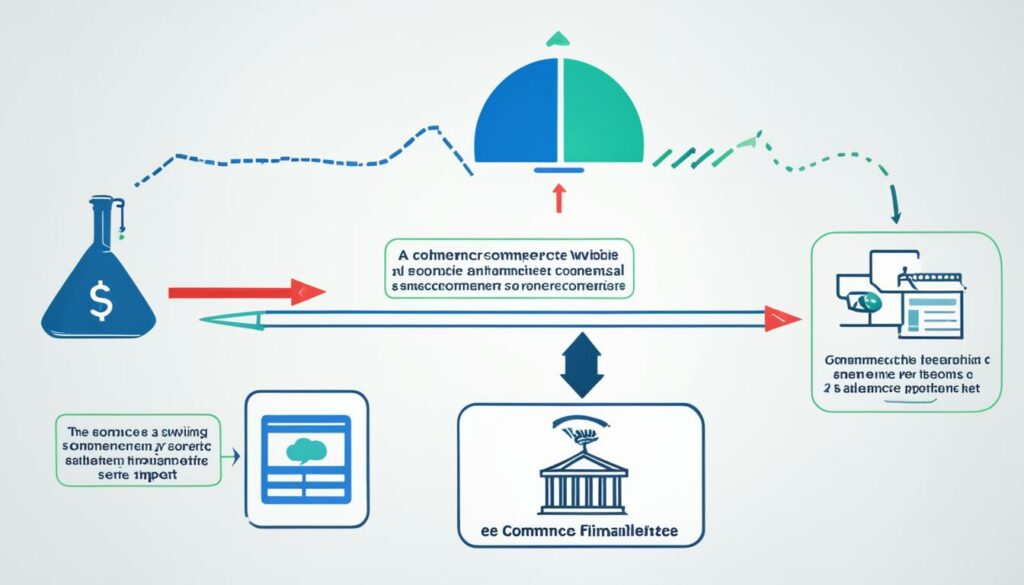A balance sheet is a vital financial statement that provides a snapshot of a company’s financial position at a specific point in time. It enables us to understand the assets, liabilities, and shareholder equity of the business. In the realm of ecommerce, a balance sheet is particularly crucial for evaluating the financial health of an ecommerce business. It aids in determining the value of the company, assessing its financial performance, and identifying areas for improvement. The balance sheet is often referred to as a statement of financial position or a statement of net worth.
With a balance sheet, we can gauge the financial snapshot of a company and analyze the balance between its assets and liabilities. This accounting document presents a comprehensive overview of the financial standing of an ecommerce business, helping owners make informed decisions to drive growth and success. It acts as a tool to evaluate the balance of a company, highlighting its strengths and weaknesses in terms of assets, liabilities, and equity.
Key Takeaways:
- A balance sheet provides a snapshot of a company’s financial position at a specific point in time.
- It outlines the assets, liabilities, and shareholder equity of the business.
- A balance sheet is essential for understanding the financial health of an ecommerce business.
- It helps determine the value of the company and assess its financial performance.
- The balance sheet is often referred to as a statement of financial position or a statement of net worth.
Definition of a Balance Sheet
A balance sheet is a financial document that presents a company’s assets, liabilities, and equity. It provides a snapshot of the company’s financial position at a specific point in time. The balance sheet equation is Assets = Liabilities + Equity. Assets represent what the company owns, liabilities represent what the company owes, and equity represents the residual value after deducting liabilities from assets. It is essentially a statement of the company’s net worth or financial snapshot.
Importance of Balance Sheet in Ecommerce
The balance sheet is a crucial financial document for any ecommerce business. It provides valuable insights into the company’s financial health and performance. By analyzing the balance sheet, ecommerce business owners can make informed decisions to improve their financial position and drive growth.
One of the key benefits of a balance sheet is that it provides an overview of the company’s assets, liabilities, and equity. This helps evaluate the company’s financial stability and determine its net worth. The balance sheet also allows owners to assess whether their equity is growing over time, indicating a positive financial trajectory.
Additionally, the balance sheet helps ecommerce business owners evaluate their investment in non-current assets. By analyzing the ratio of non-current assets to total assets, owners can ensure that they are not tying up excessive resources in assets that may not be generating sufficient returns.
Working capital is another important aspect of the balance sheet. It represents the amount of money tied up in the day-to-day operations of the business. By assessing the working capital position, owners can optimize their cash flow and ensure that the business has enough liquidity to cover its obligations.
Furthermore, the balance sheet provides a snapshot of the company’s liabilities. Comparing the liabilities to the assets can help ensure that the company has enough resources to cover its financial obligations and avoid potential financial trouble.
Overall, the balance sheet serves as a tool for decision-making and enables owners to gauge the financial health of their ecommerce business. It allows for strategic planning, identifying areas for improvement, and recognizing potential risks. By regularly reviewing and analyzing the balance sheet, ecommerce business owners can maintain a strong financial position and drive long-term success.

Strategies to Improve Balance Sheet in Ecommerce
Improving the balance sheet of an ecommerce business is crucial for ensuring a strong financial position. By implementing effective strategies, businesses can enhance their financial health and optimize their assets, liabilities, and equity. Here are some key strategies that ecommerce businesses can utilize to improve their balance sheet:
- Increase profitability: By focusing on strategies to boost sales revenue, streamline operations, and reduce costs, ecommerce businesses can enhance their profitability. Effective marketing campaigns, pricing strategies, and cost-saving initiatives can all contribute to a stronger balance sheet.
- Reduce unnecessary expenses: Conduct a thorough review of all business expenses to identify areas where costs can be cut or minimized. This can involve negotiating better deals with suppliers, finding more cost-effective shipping solutions, or optimizing advertising and marketing expenses.
- Manage inventory levels effectively: Maintaining an optimal balance between supply and demand is crucial for ecommerce businesses. By accurately forecasting sales and managing inventory levels, businesses can avoid excess stock and reduce carrying costs, leading to improved asset turnover and a healthier balance sheet.
- Optimize working capital: Efficient management of working capital is vital for a healthy balance sheet. Ecommerce businesses should focus on improving cash flow by ensuring prompt invoicing and collections, managing payables strategically, and optimizing inventory turnover.
- Negotiate better terms with suppliers: Collaborate with suppliers to negotiate better pricing, payment terms, or volume discounts. This can help reduce costs, improve cash flow, and strengthen the balance sheet.
- Implement efficient accounts receivable and payable processes: Streamline accounts receivable processes to ensure timely collection of payments from customers. Additionally, optimize accounts payable processes to take advantage of early payment discounts and avoid late payment penalties.
By implementing these strategies, ecommerce businesses can improve their balance sheet, strengthen their financial health, and position themselves for long-term success in the competitive ecommerce landscape.

Customer Behavior and the Balance Sheet
Customer behavior plays a significant role in shaping the financial performance of an ecommerce business, ultimately reflected in the company’s balance sheet. The way customers interact with a business directly impacts its sales, revenue, and profitability. Positive customer behavior, such as repeat purchases and brand loyalty, can drive higher sales and increase the value of assets recorded in the balance sheet. Conversely, negative customer behavior, such as high product returns or low customer retention rates, can result in lower revenue and have a detrimental effect on the balance sheet.
Understanding and optimizing customer behavior is crucial for maintaining a healthy balance sheet and sustaining the financial performance of an ecommerce business. By analyzing customer behavior data, businesses can gain valuable insights into customer preferences, needs, and buying patterns. This data can inform strategies for personalized marketing, customer retention, and product development, ultimately leading to increased sales and improved financial performance.
“Customer behavior is a key driver of financial success in ecommerce. By focusing on providing exceptional customer experiences and nurturing brand loyalty, ecommerce businesses can build a solid foundation for a positive balance sheet.”
Furthermore, customer behavior analysis can also help identify potential risks and challenges that may impact the balance sheet. For example, analyzing customer feedback and reviews can reveal product performance issues or areas for improvement, which, if addressed promptly, can minimize product returns and associated financial losses. Similarly, monitoring customer retention rates can provide insights into the effectiveness of customer satisfaction and loyalty strategies, enabling proactive measures to mitigate customer churn and maintain revenue stability.
Overall, by prioritizing customer behavior analysis and leveraging data-driven insights, ecommerce businesses can align their strategies with customer expectations, drive revenue growth, and maintain a healthy balance sheet.

The Balance Sheet and its Relation to Other Metrics
The balance sheet is a fundamental component of financial statement analysis and plays a crucial role in evaluating an ecommerce business’s financial health and performance. It serves as a source of valuable information for calculating various business metrics that provide insights into the company’s assets, liabilities, and equity.
By analyzing the balance sheet, business owners can calculate important ratios such as the debt-to-equity ratio, current ratio, and return on equity. These ratios offer a comprehensive assessment of the business’s financial position, liquidity, and efficiency. They help identify the company’s ability to meet its financial obligations, manage its assets and liabilities, and generate profits.
Furthermore, analyzing the balance sheet alongside these metrics enables business owners to make well-informed decisions that drive growth and success. It allows them to identify areas of improvement, optimize their financial strategies, and allocate resources effectively. By maintaining a strong balance sheet and monitoring these metrics regularly, ecommerce businesses can navigate challenges, seize opportunities, and achieve their financial objectives.
FAQ
What is a balance sheet?
A balance sheet is a financial statement that provides a snapshot of a company’s financial position at a specific point in time. It outlines the assets, liabilities, and shareholder equity of the business.
What is the purpose of a balance sheet in ecommerce?
A balance sheet is crucial in understanding the financial health of an ecommerce business. It helps determine the value of the company, assess its financial performance, and identify areas for improvement.
How does a balance sheet relate to other business metrics?
The balance sheet is a key component of financial statement analysis and is closely related to other important business metrics. It provides valuable information for calculating ratios such as the debt-to-equity ratio, current ratio, and return on equity.
How can I improve the balance sheet of my ecommerce business?
Strategies to improve the balance sheet include increasing profitability, reducing unnecessary expenses, managing inventory levels effectively, optimizing working capital, negotiating better terms with suppliers, and implementing efficient accounts receivable and payable processes.
Why is customer behavior important for the balance sheet?
Customer behavior plays a significant role in the financial performance reflected in a company’s balance sheet. It affects the sales of products or services, which directly impacts the revenue and profitability of an ecommerce business.
